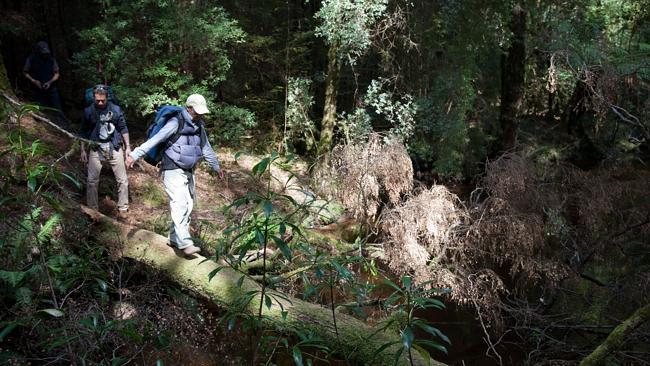
THE debate around whether Tasmania should log or protect its remaining wild forests used to be so simple; a clear-cut case of greenies v loggers.
These days, however, Tassie’s forests conundrum has become as twisted and gnarly as the moss-covered roots and trunks of the island’s ancient rainforests.
This week the Hodgman Liberal government, elected on March 15, revealed its forest policy. It seeks to make good on the Liberals’ election pledge to “tear up” the forest peace deal, also known as the Tasmanian Forest Agreement, that was enshrined in law by the former Labor-Greens government last May.
The Hodgman plan will rescind reserve status for 400,000ha of native forests that were to be given permanent protection from October this year, under the legislation.
Instead, these forests — including swift parrot habitat on Bruny Island and tracts of the Tarkine rainforest and the Blue Tier — will be designated as “future potential production forest”.
That means these forests are earmarked for logging once again, although a six-year moratorium on harvesting will ensure it does not occur any time soon.
Premier Will Hodgman hails the policy as “elegant”, conservationists call it “tricky” and the peak timber industry group is concerned about the ramifications. The public is simply confused.
The six-year delay is in part an acknowledgment that timber volumes agreed in the peace deal are sufficient to meet existing demand, in the short term.
Holding the 400,000ha in limbo for six years will ensure that, in the long term, the industry can grow — in theory, at least — even if a maturing plantation resource proves unsuitable.
Politically, it is about doing enough to deliver on an election slogan without precipitating a full-scale return to the forest wars. It’s a concession that a return to protests and consumer campaigns could spook key markets in Japan and on the Australian mainland that are only just recovering.
The deal seeks to retain trust with voters in regional seats who blamed conservationists for the collapse in the timber sector, and who feel the “greenies” have called the shots for too long.
Hodgman is trying, though, to retain elements of the peace deal that are good for industry, including the promise of top-flight environmental certification, presently being assessed by the Forest Stewardship Council.
To address concerns about the potential impact of the new policy on FSC certification, increasingly demanded by customers, the government is transferring the 400,000ha of ex-reserve land to Crown Land Services.
This keeps these forests off the books of the state-owned Forestry Tasmania, the entity seeking certification.
FSC can consider what happens only in the forests under Forestry Tasmania’s control; not the fate of the 400,000ha held by Crown Land.
The government is confident this will “ring-fence” Forestry Tasmania from the fallout.
Conservation groups, such as The Wilderness Society and the Australian Conservation Foundation, do not have a veto over FSC but their concerns are taken seriously by its auditors.
Under the peace deal, these green groups dropped any objection about logging inside the 750,000ha of permanent production forest that remained under Forestry Tasmania control. This was done on the basis that 504,012ha of other forests were permanently protected in reserves.
However, with the government stripping protection for 400,000ha of that 504,012ha (the remainder having already been granted World Heritage status), all bets will be off.
Areas inside the previously agreed 750,000ha Forestry Tasmania production zone will suddenly become contentious once more now that the offsetting reserves are gone.
Ring fence or no, this could complicate Forestry’s bid to gain FSC certification and potentially force it to make further concessions on practices within its production forests.
And those concessions could reduce, rather than increase, wood supply.
Certainly, industry can no longer count on conservationists’ support for FSC. Under the peace deal legislation, green groups were obliged to help industry achieve FSC by October — or else the reserves did not receive permanent protection.
Under Hodgman’s plan, that imperative to help is gone; a fact that may not escape the independent-dominated upper house, which will have the final say on the bid to repeal legislation it approved only 11 months ago.
Perhaps the biggest potential flaw in the government’s plan is what happens in 2020, when the moratorium on logging the 400,000ha of “limbo” forests expires. If those forests — verified under an agreed process as containing high conservation values — are logged by Forestry Tasmania, the agency would risk losing FSC certification.
The lead FSC auditor assessing Forestry Tasmania, Robert Hrubes, made this clear to Inquirer: “If Forestry Tas was involved in the logging of that 400,000ha, then that would have bearing upon the scope of our certification.”
Even if the agency were merely employed as a contractor, it would still risk breaching FSC’s “policy for association”, which prevents companies operating under best practice in one area while behaving badly elsewhere.
“If it turned out that within that 400,000ha there were areas of special high conservation values and those were indiscriminately logged, and if Forestry Tas was involved, even though they were just the contractor, the policy for association would apply,” Hrubes says. “It would be germane to their ability to achieve or maintain certification.”
The government could bring in an interstate or private company to handle the job of logging these forests, but Forestry Tasmania’s knowledge and expertise is likely to be required. Besides, this week Resources Minister Paul Harriss confirmed the task would fall to Forestry Tasmania.
The government has justified its actions partly on the basis that the state’s specialty timbers industry — makers of fine furniture and wooden boats — may need more special species wood than the peace deal provides.
Hodgman’s six-year moratorium on logging the 400,000ha does not apply to this sector, which may be granted “limited” access earlier if it can demonstrate need. However, once again, this is far from assured.
The peace deal legislation already provides for logging in reserves for special timbers, such as sassafras and celery top, if necessary. Approval is difficult but, once given, would be within the deal framework.
Without that cover, any such harvesting is likely to be hotly contested and Forestry Tasmania may risk FSC certification by being involved.
So while Hodgman claims to be about providing more wood for industry, his plan could conceivably end up providing less; while potentially jeopardising key markets that are demanding conflict-free products.
Harriss denies the government’s shake-up will have perverse outcomes.
“The government … has put in place policy settings which will enable the industry to grow over time, and does not foresee less wood being available from land managed by Forestry Tas,” he tells Inquirer.
The Special Timber Alliance is not yet “overly concerned” but is pushing the government to develop a more complete strategy to head-off any pitfalls.
More worried is the Forest Industries Association of Tasmania, which represents the largest sawmillers and veneer maker Ta Ann. It warns the government its “unseemly haste” risks “ramifications in a broad range of areas” for the sector.
The new Liberal government is learning the hard way that, these days, nothing is simple about forestry.



